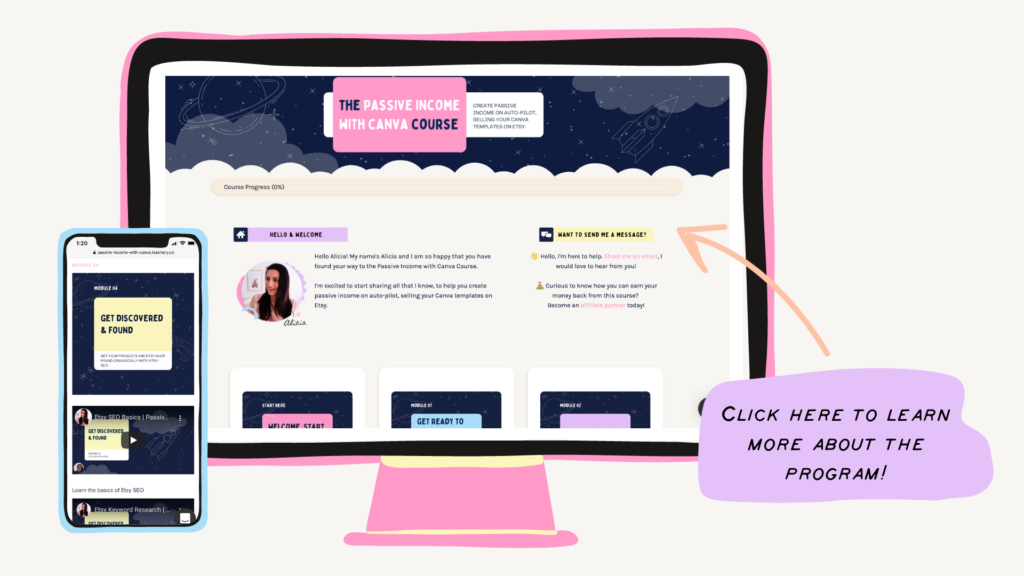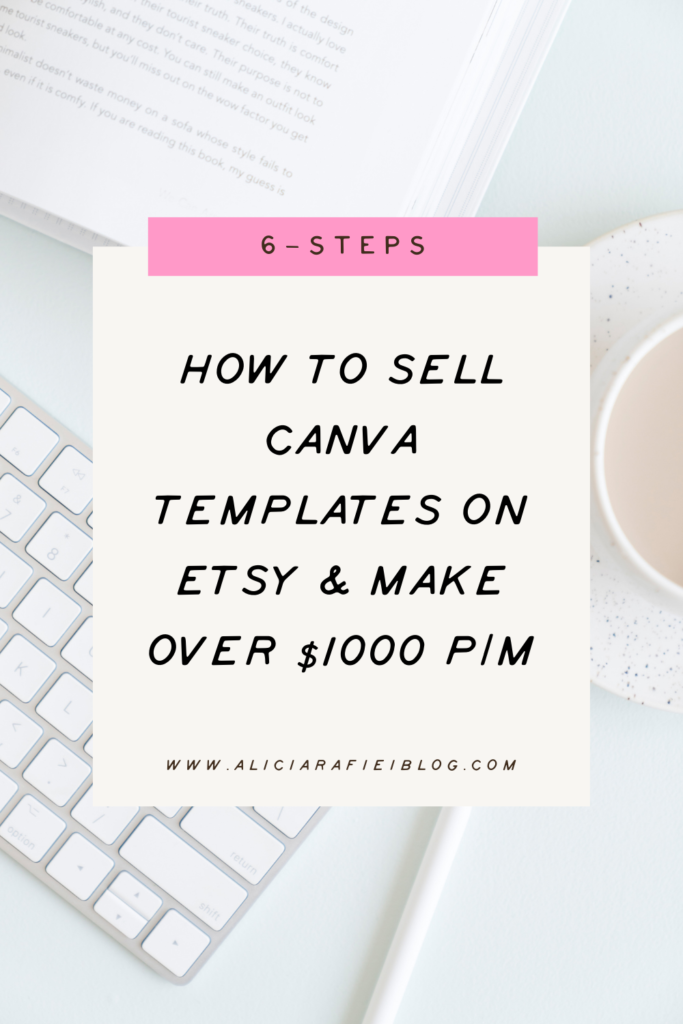
Want to start generating over $1,000 of passive income per month, selling Canva Templates on Etsy?
If you answered “YES”, then you’ll want to check out this article where I share the 6 steps that I have gone through myself and recommend to my students to help them start and launch a successful Etsy shop selling Canva Templates.
If you’re new to the blog, firstly it’s so wonderful that you’ve stumbled upon this article and secondly I’m super excited that you’ve landed here as you’re in for a treat.
Because today I’ll be sharing the 6-steps that helped me grow my own Etsy shop to over $1,000 months selling digital products on Etsy, specifically Canva templates that I create once and then sell over and over (and over) again, generating passive income. With the majority of these sales coming through in my sleep!
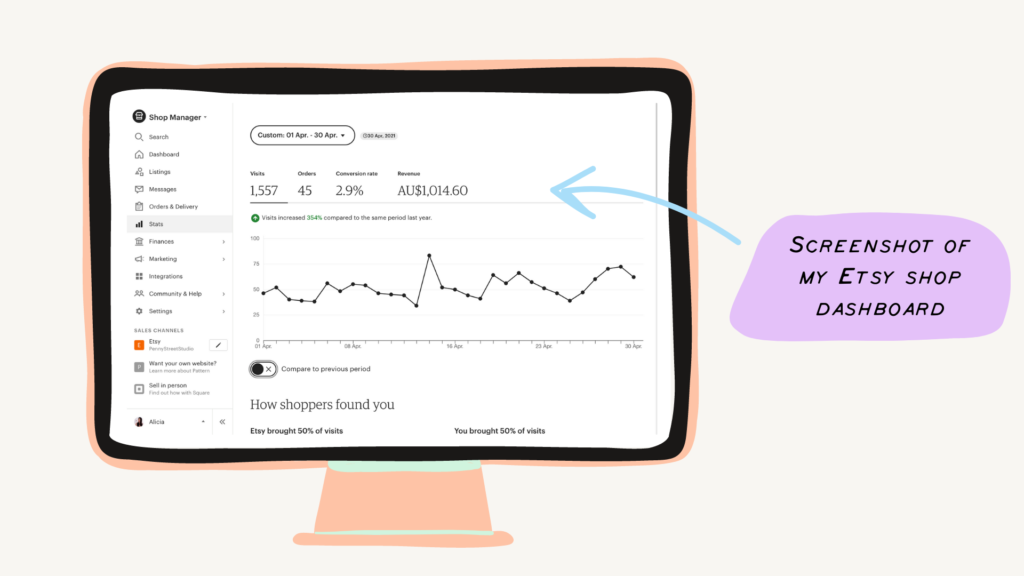
It almost sounds like a dream right?
But if I can do it, I believe anyone can and with the right education and tools, you’ll be achieving these kinds of results too.
Okay, ready to get into the 6 steps?
Step 1: Market Research & Product Validation
The very first step you need to do before you even create your first Canva template or open up your Etsy shop is you need to ensure that you have done your market research and checked to make sure that the product you want to sell is something customers want to buy.
Now research and product validation doesn’t have to be a long and scary process, in fact, it can be easy and fun.
All you need to do is come up with a list of products you would like to sell. Let’s say you wanted to sell social media marketing canva templates in your shop. Your list of templates might include Instagram Post templates, Instagram Stories templates, Pinterest Pin templates, Facebook Post templates etc.
Once you’ve come up with your list, what you want to do next is pop on over to your computer, open up Etsy (preferably in an incognito window) and add your keywords and phrases into the search box. In this case the specific marketing templates from your list.
Before you hit [Enter], Etsy will then list out all the other search terms and phrases that customers are searching for right there on the screen. This is usually a good indication that these items are being searched and purchased on Etsy. When you’re ready, go ahead and pick one of these search phrases to dive deeper and discover what listings show up.
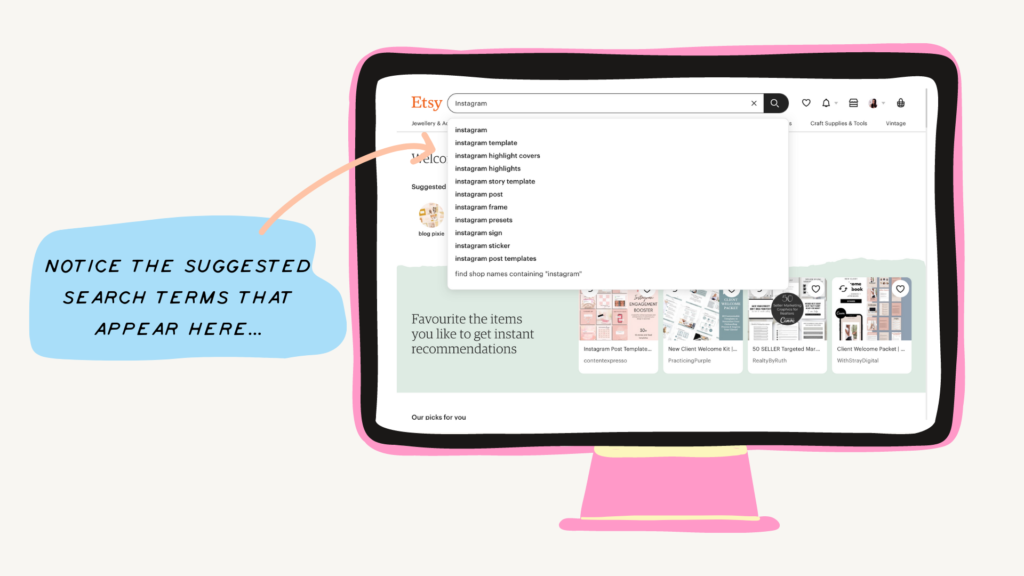
On the first page, Etsy will display the best sellers for that search term. This is where you want to dive into individual listings to get a deeper look into what is currently available under this search term, what people are searching & what customers are buying. This is also an opportunity for you to notice some of the elements or designs you could create or improve on to then sell in your own shop.
NOTE: Obviously, we’re not in the business of copying so it goes without saying that all of this is for research purposes only. Please do not copy other people’s work.
Step 2: Define Your Ideal Customer
Okay now that you have an idea of what type of templates you’d like to sell, now’s the time to narrow down your products by understanding who is going to buy them.
Understanding who your templates are made for will not only help you to create a more consistent brand and business on Etsy, it will also attract even more of those same customers to your shop.
When defining your ideal customer avatar you want to be answering a few specific questions about them. Specifically, you want to be thinking about not only their demographics, but you want to also be answering questions about what they care about and also their psychographics too.
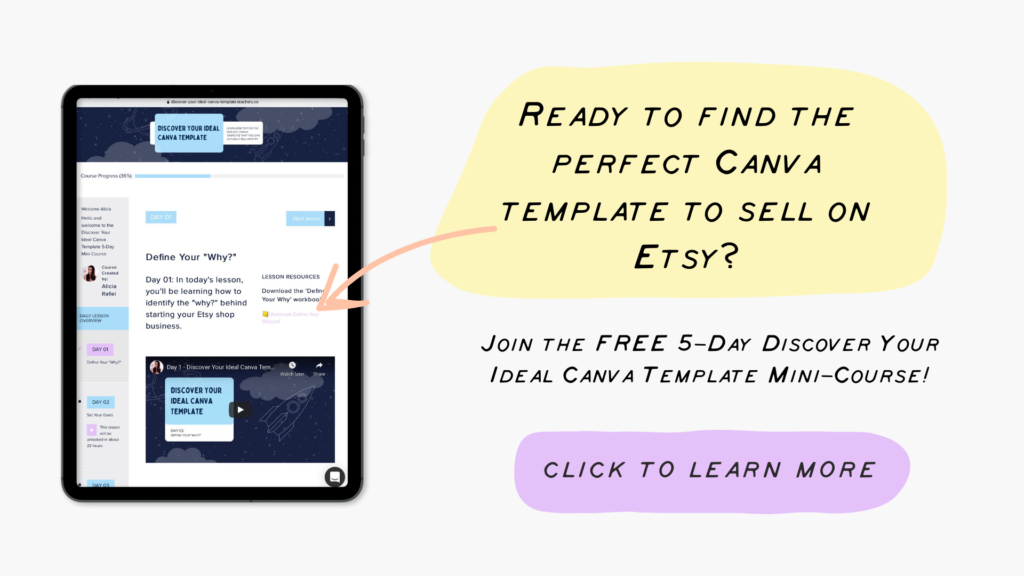
Step 3: Set Up Your Business Branding
Now that you know what you’re selling and who you’re selling to, it’s now time to start developing your business brand so you can start attracting traffic to your Etsy shop, people who will eventually go on to buy.
The one key thing you want to think about when developing your business brand is creating a brand that your ideal customer will be attracted to.
For example, an Etsy shop that sells wedding invitation templates will attract an entirely different customer to an Etsy Shop selling presentation templates to educators who create online lessons for children.
The shop selling wedding templates might have a brand that has a more delicate colour palette and uses light floral elements, whereas a shop selling presentation templates for young children would have a brand with more bright and playful colours and use bold, big and bright elements.

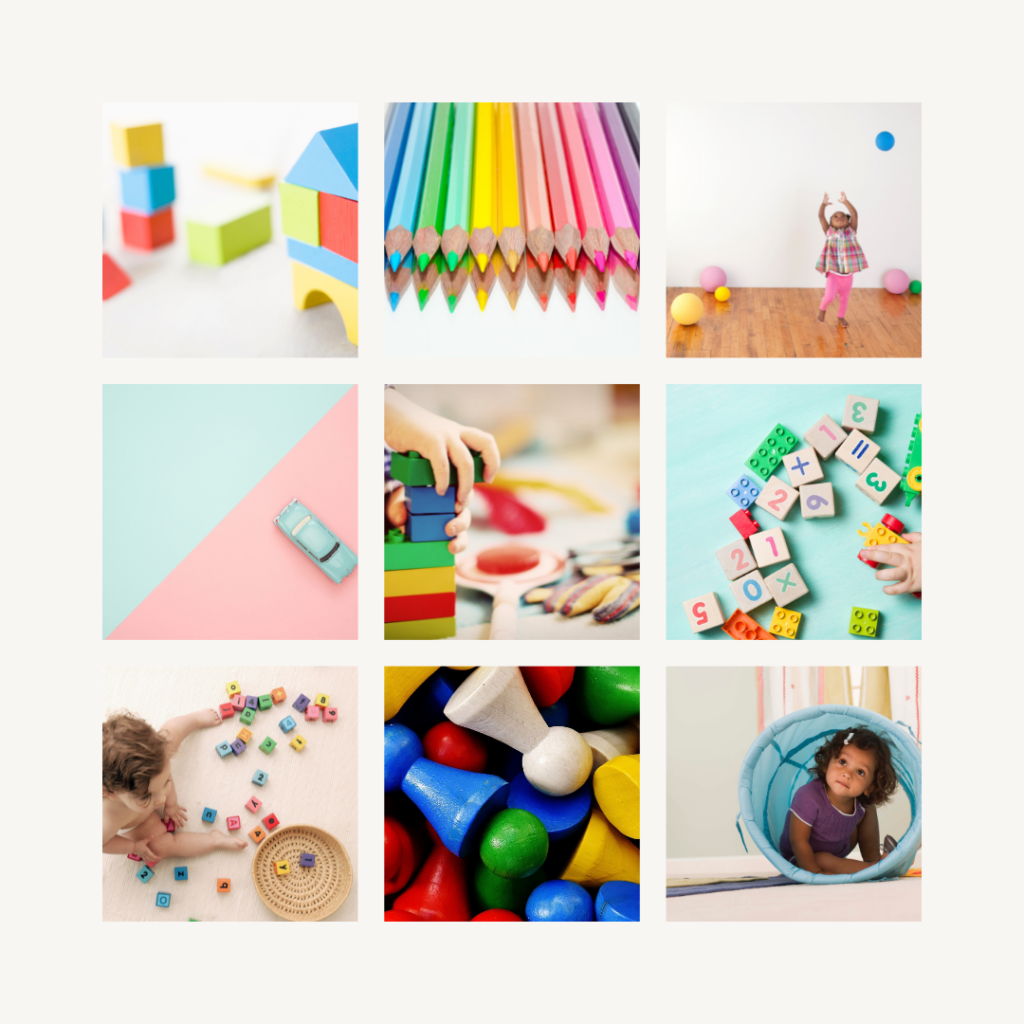
Step 4: Create and develop your first Canva Templates
Okay, here’s where the fun begins. It’s now time to create your first (or next) Canva template to then go ahead and sell on Etsy.
Now in order to create templates that you can eventually sell on Etsy, you must have access to a Canva Pro account.
Why is it so important to have a Canva Pro account?
Well, because without it, you’ll be unable to share the download link that is sent to your customer once a purchase has been confirmed. This ensures that you’re selling a ‘copy’ of your original design without ever having the original edited, changed or modified by any other user.
If you’re yet to sign up for a Canva Pro account, be sure to click here for access to a 30-day free trial.
When designing your first Canva template, to avoid designer burnout or overwhelm, I suggest writing out a list of all the things you would like to include in your template (i.e the pages of your design). This way you’ll have a guide on what you want to create and aren’t left staring at a blank template with no direction on where to start.
If it helps, be sure to check out some of the other templates that are currently on Canva to get an idea of what you might want to include in your template and see what’s popular with Canva users right now.
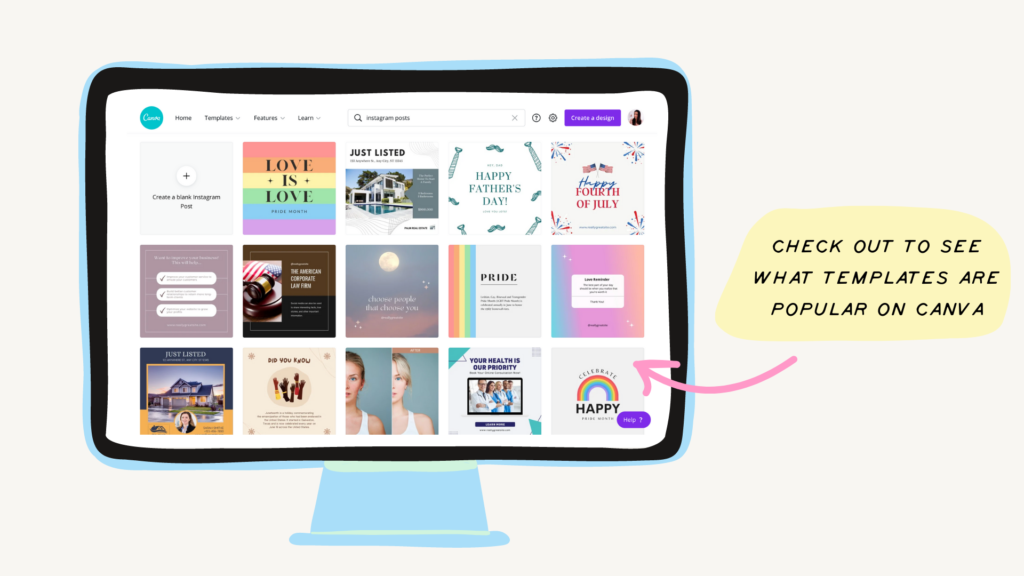
Again, this is to be used as inspiration only. It’s actually against Canva’s terms of use to edit or alter any original Canva design and then go ahead and sell it as your own. The best way to avoid this is to just start from a blank template and design your product from scratch.
Step 5: Set-Up Your Etsy Shop
Once you have your first Canva template created, you’ve created the PDF deliverable (this is the document that will store your sharable template link) and you have around 10 listing images ready to go, it’s now time to open up your Etsy shop and list your first template.
Woohoo.
Opening up your new Etsy shop is easy. All you need to do is sign up for a seller account with an email address and then follow the prompts to add in your personal details, your bank account details (so you can get paid) and then add your first product to open up your shop. From here you can update your Etsy shop branding by adding in your branded logo, shop banner and even a branded order receipt banner too.
You can see how all of the previous four steps have built up to finally launch your first template on Etsy, with a professional-looking shop. By putting in all the hard work upfront, you can now easily and effortlessly add your products and start working towards your first sale.
Step 6: Etsy Keyword Research and Optimise your Listings for SEO
Once you have your first product listed, you want to start thinking about how you’re going to ensure it’s seen by as many of your ideal customers as possible.
And the best way to do this is through Etsy SEO.
Etsy SEO or Search Engine Optimisation is Etsy’s way of helping more customers find your products.
Ensuring that you have included keyword-rich titles and tags in your product listing, will help Etsy show your products to the right people, the exact people searching for what you’re selling.
If you want to dive into Etsy SEO and keyword research in more detail, I have a short video playlist on YouTube that includes a video running through the basics of Etsy SEO (for beginners) and also a tutorial video on how you can find the best keywords for your listings.
Bonus Step: Boost Sales and Traffic with Etsy Ads & Social Media
Once you have your Etsy shop established, you’re creating and uploading Canva templates to your shop, you’ve nailed your SEO and optimised your listings with rich keywords and phrases now it’s time to boost your efforts by marketing your Etsy shop with things like Etsy Ads, Pinterest, Instagram or Facebook.
Ensuring that you are diversifying your traffic sources helps you to gain more customers to your Etsy shop to go on to buy your templates.
Personally, I have had success with both Pinterest marketing and also Etsy Ads in my own shop so it’s certainly the two that I would suggest starting with. Then once you have the hang of it, then by all means try some different marketing methods, such as posting on Instagram, Facebook or even TikTok.
The main thing to take note of is that in order to succeed on any social platform, you need to be consistent, so make sure that when you commit to marketing on multiple platforms, you have the time to dedicate to it.
How you can start an Etsy shop that generates over $1,000 p/m of passive income.
Okay, so there we go friends, the 6 steps (with a bonus step included) on how you can start, launch and grow an Etsy shop selling Canva templates to 1,000K months or more, just like I have with my own Etsy shop Penny Street Studio.
These are the exact steps I teach to my students inside the Passive Income with Canva course, so if you want to take these learnings even further and want a more in-depth step-by-step process with lessons and tutorials, then be sure to check it out.
This is the course I created based on the exact steps, strategies and learnings I have made whilst growing my own Etsy shop to $1,000k + months. You can learn more or sign up for the program by clicking here.
